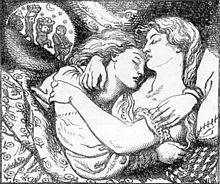
The Pre-Raphaelite Brotherhood was a group of English painters, poets, and art critics, founded in 1848 by William Holman Hunt, John Everett Millais, Dante Gabriel Rossetti, William Michael Rossetti, James Collinson, Frederic George Stephens and Thomas Woolner who formed a seven-member "Brotherhood" partly modelled on the Nazarene movement. The Brotherhood was only ever a loose association and their principles were shared by other artists of the time, including Ford Madox Brown, Arthur Hughes and Marie Spartali Stillman. Later followers of the principles of the Brotherhood included Edward Burne-Jones, William Morris and John William Waterhouse.

Gabriel Charles Dante Rossetti, generally known as Dante Gabriel Rossetti, was an English poet, illustrator, painter, translator, and member of the Rossetti family. He founded the Pre-Raphaelite Brotherhood in 1848 with William Holman Hunt and John Everett Millais. Rossetti inspired the next generation of artists and writers, William Morris and Edward Burne-Jones in particular. His work also influenced the European Symbolists and was a major precursor of the Aesthetic movement.

Christina Georgina Rossetti was an English writer of romantic, devotional and children's poems, including "Goblin Market" and "Remember". She also wrote the words of two Christmas carols well known in Britain: "In the Bleak Midwinter", later set by Gustav Holst, Katherine Kennicott Davis, and Harold Darke, and "Love Came Down at Christmas", also set by Darke and other composers. She was a sister of the artist and poet Dante Gabriel Rossetti and features in several of his paintings.
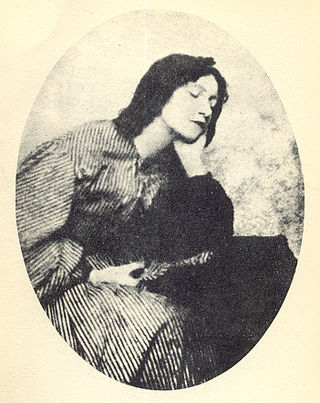
Elizabeth Eleanor Siddall, better known as Elizabeth Siddal, was an English artist, art model, and poet. Siddal was perhaps the most significant of the female models who posed for the Pre-Raphaelite Brotherhood. Their ideas of female beauty were fundamentally influenced and personified by her. Walter Deverell and William Holman Hunt painted Siddal, and she was the model for John Everett Millais's famous painting Ophelia (1852). Early in her relationship with Dante Gabriel Rossetti, Siddal became his muse and exclusive model, and he portrayed her in almost all his early artwork depicting women.
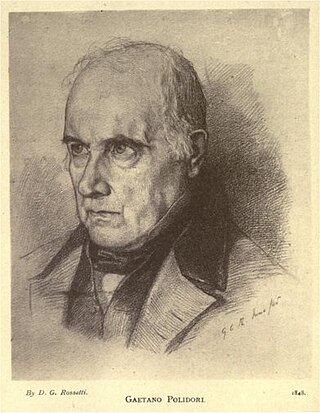
Gaetano Fedele Polidori was an Italian writer, political and scholar living in Highgate. He was the son of Agostino Ansano Polidori (1714–1778), a physician and poet who lived and practised in his native Bientina, near Pisa, Tuscany.

William Michael Rossetti was an English writer and critic.
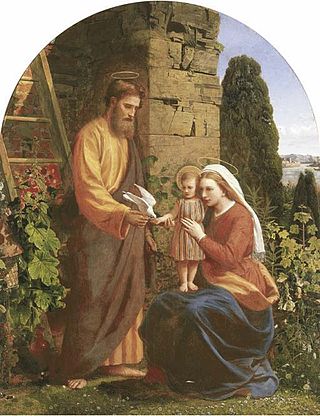
James Collinson was a Victorian painter who was a member of the Pre-Raphaelite Brotherhood from 1848 to 1850.

Oranges Are Not the Only Fruit is a novel by Jeanette Winterson published in 1985 by Pandora Press. It is a coming-of-age story about a lesbian who grows up in an English Pentecostal community. Key themes of the book include transition from youth to adulthood, complex family relationships, same-sex relationships, organised religion and the concept of faith.
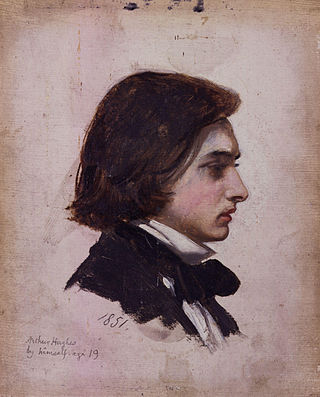
Arthur Hughes was an English painter and illustrator associated with the Pre-Raphaelite Brotherhood.
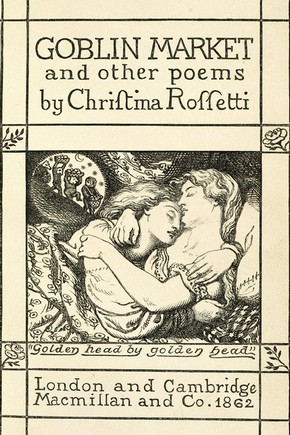
Goblin Market and Other Poems is English writer Christina Rossetti's first volume of poetry, published by Macmillan in 1862. It contains her famous poem "Goblin Market" and others such as "Up-hill", "The Convent Threshold", and "Maude Clare." It also includes the poem 'In the Round Tower at Jhansi, 8 June 1857', in which a British army officer takes his wife's life and his own so that they do not have to face death at the hands of the rebelling soldiers, commemorating the Jhokan Bagh massacre at Jhansi. Christina's brother, founding Pre-Raphaelite Brotherhood member Dante Gabriel Rossetti, designed the frontispiece and title page illustrations in the first edition, as well as the minimal blue binding. Christina was aware that her brother's "commercial savvy and artistic skill" helped make her first volume of poetry a success.

Maria Francesca Rossetti was an English author and nun. She was the sister of artist Dante Gabriel Rossetti and William Michael Rossetti, and of Christina Georgina Rossetti, who dedicated her 1862 poem Goblin Market to Maria.
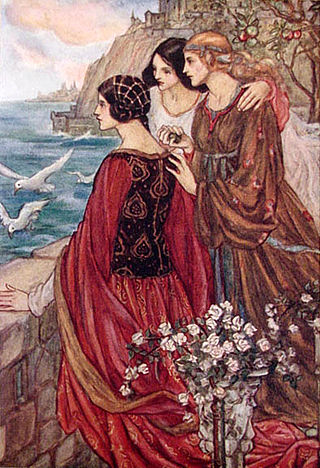
Florence Susan Harrison (1877–1955) was an Australian illustrator of poetry and children's books in Art Nouveau and Pre-Raphaelite styles. Many of her books were published by Blackie and Son. She illustrated books by Pre-Raphaelite circle poets Christina Rossetti, William Morris and Sir Alfred Tennyson.

"The Blessed Damozel" is perhaps the best known poem by Dante Gabriel Rossetti, as well as the title of his painting illustrating the subject. The poem was first published in 1850 in the Pre-Raphaelite journal The Germ. Rossetti subsequently revised the poem twice and republished it in 1856, 1870 and 1873.
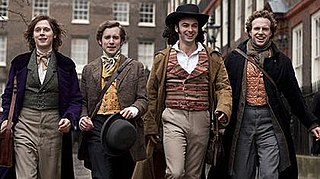
Desperate Romantics is a six-part television drama serial about the Pre-Raphaelite Brotherhood, first broadcast on BBC Two between 21 July and 25 August 2009.
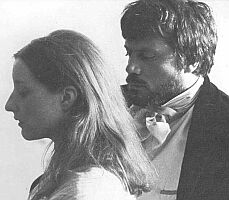
Dante's Inferno: The Private Life of Dante Gabriel Rossetti, Poet and Painter (1967) is a feature-length 35 mm film directed by Ken Russell and first screened on the BBC on 22 December 1967 as part of Omnibus. It quickly became a staple in cinemas in retrospectives of Russell's work. Using nonlinear narrative technique, it tells of the relationship between the 19th-century artist and poet Dante Gabriel Rossetti and his model, Elizabeth Siddal.

Proserpine is an oil painting on canvas by English artist and poet Dante Gabriel Rossetti, painted in 1874 and now in Tate Britain. Rossetti began work on the painting in 1871 and painted at least eight separate versions, the last only completed in 1882, the year of his death. Early versions were promised to Charles Augustus Howell. The painting discussed in this article is the so-called seventh version commissioned by Frederick Richards Leyland, now at the Tate Gallery, with the very similar final version now at the Birmingham Museum and Art Gallery.
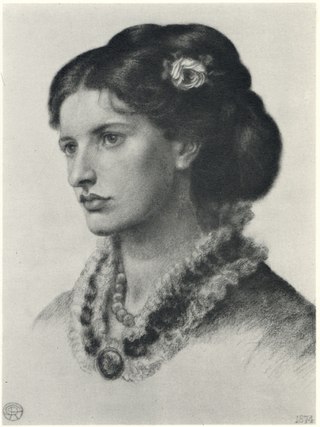
Lucy Madox Brown Rossetti was a British artist, author, and model associated with the Pre-Raphaelites. She was married to the writer and art critic William Michael Rossetti.

Fanny Eaton was a Jamaican-born artist's model and domestic worker. She is best known as a model for the Pre-Raphaelite Brotherhood and their circle in England between 1859 and 1867. Her public debut was in Simeon Solomon's painting The Mother of Moses, which was exhibited at the Royal Academy in 1860. She was also featured in works by Dante Gabriel Rossetti, John Everett Millais, Joanna Mary Boyce, Rebecca Solomon, and others.
Kate Faulkner (1841–1898), was an Arts and Crafts artist and designer.

Venus Verticordia (1864–1868) by Dante Gabriel Rossetti is a semi-nude depiction of the goddess Venus, portrayed as a young woman with a golden halo and flowing auburn hair, surrounded by pink flowers in a dark, lush green garden. Her left breast is visible, while the right is obscured by the golden apple she holds in her left hand. In her right hand she holds an arrow, the point directed towards her own heart, and on which rests a small yellow butterfly. Other similar butterflies ring the halo surrounding her head, and another sits on top of the apple she holds.
